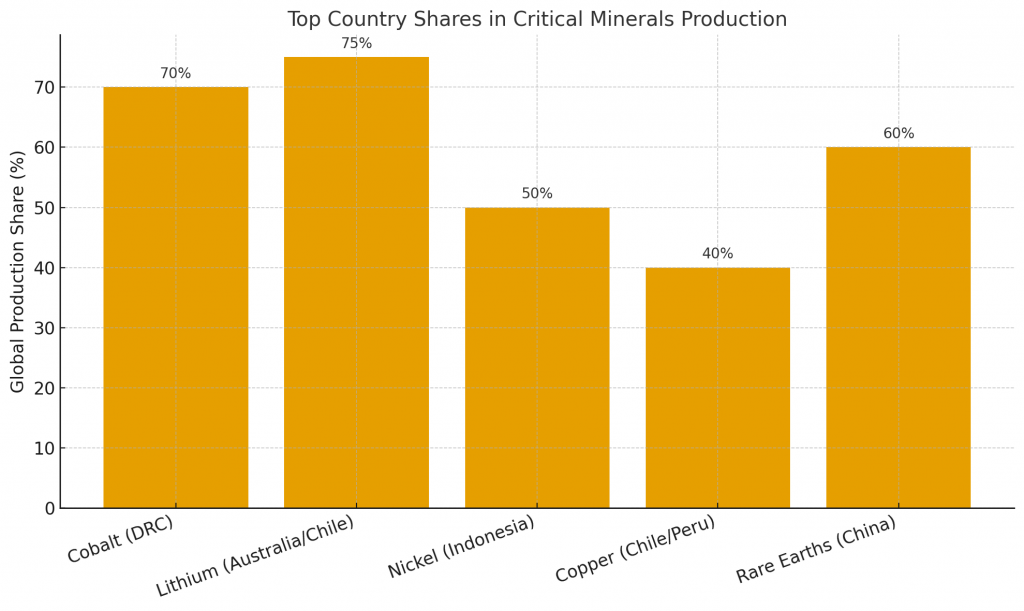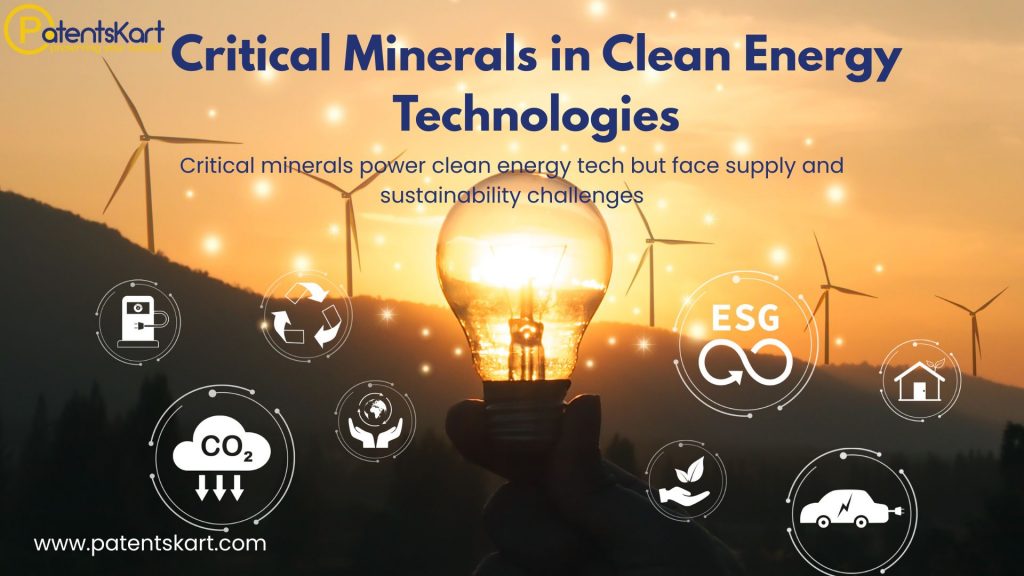What are critical minerals and why do they matter today?
Critical minerals are the essential raw materials powering today’s clean energy revolution. They include lithium, cobalt, nickel, rare earth elements, copper, and graphite. These resources are vital for technologies like electric vehicles (EVs), solar panels, wind turbines, energy storage, and smart grids. Without them, achieving global decarbonization goals would be nearly impossible.
Over the past decade, the term has moved from technical reports into mainstream policy debates. Governments, companies, and researchers now view these strategic minerals as the “new oil,” driving not just energy innovation but also global competition.
How are critical minerals in clean energy technologies driving demand?

The International Energy Agency (IEA) projects that demand for clean energy technologies will more than triple the need for certain resources by 2040. Lithium demand could rise 40 times, driven largely by electric vehicle batteries. Graphite demand may surge 20 times, and cobalt is expected to grow six to seven times.
For critical minerals in clean energy, the largest demand comes from:
- Electric vehicles (EVs): Lithium, nickel, cobalt, and graphite for batteries.
- Wind turbines: Rare earth elements such as neodymium and dysprosium for permanent magnets.
- Solar panels: Silver and silicon.
- Grid infrastructure: Copper and aluminum for transmission and smart grids.
This rising demand positions these clean energy minerals as the foundation of future energy systems.
Why are critical minerals for EV batteries a game-changer?
Electric vehicles are the single largest driver of mineral demand. A standard EV battery requires:
- ~8 kg of lithium,
- ~35 kg of nickel,
- ~20 kg of manganese,
- ~14 kg of cobalt,
- and over 40 kg of graphite.
That means millions of tons of critical minerals for EV batteries will be required each year as automakers scale production. Tesla, BYD, Volkswagen, and other major players are investing heavily in supply agreements and recycling initiatives to secure their share.
Without reliable access to these vital raw materials, EV adoption could slow down, threatening climate goals.
Which countries dominate the critical minerals supply chain?

One of the biggest challenges is the critical minerals supply chain being heavily concentrated:
- Cobalt: More than 70% comes from the Democratic Republic of Congo (DRC).
- Rare earth elements: China controls 60% of mining and 80–90% of processing.
- Lithium: Australia, Chile, and Argentina are leading producers.
- Nickel: Indonesia and the Philippines dominate.
- Copper: Chile and Peru account for nearly 40% of global output.
This concentration poses geopolitical risks. A disruption in one region can ripple across industries, from EV manufacturing to renewable energy deployment.
Which critical minerals companies are leading the market?
A mix of mining giants and emerging players are shaping the landscape:
- Mining majors: BHP, Rio Tinto, Glencore, Albemarle, and Teck dominate large-scale critical minerals companies operations.
- Rare earth leaders: Lynas (Australia) and MP Materials (US) are strengthening Western supply chains.
- Battery-focused firms: CATL and Panasonic are securing upstream mineral partnerships.
These companies are not only extracting but also investing in refining and recycling technologies to reduce environmental impacts.
How are critical minerals startups driving innovation?
Startups are pushing boundaries with new technologies that can transform the sector. Notable critical minerals startups include:
- Redwood Materials: Pioneering battery recycling to recover lithium, cobalt, and nickel.
- KoBold Metals: Using artificial intelligence to identify new mineral deposits.
- The Metals Company: Exploring deep-sea mining for polymetallic nodules rich in cobalt and nickel.
These innovators are complementing traditional mining by offering solutions that are more sustainable, efficient, and future-ready.
What role do patents play in critical minerals innovation?
Patents are essential in shaping the technological future of this sector. Companies and researchers are racing to file critical minerals patents around:
- Solid-state batteries that use less cobalt.
- Recycling methods for lithium-ion batteries (urban mining).
- Rare-earth-free magnets to reduce dependency on China.
- Advanced extraction processes such as bioleaching and membrane separation.
The surge in these minerals patents shows that intellectual property is a competitive advantage. Organizations that secure patents in battery chemistry, processing, and recycling will define tomorrow’s energy leaders.
What are the challenges in critical minerals mining?
While opportunities are vast, critical minerals mining comes with major challenges:
- Environmental impacts: High water use in lithium extraction, habitat disruption, and CO₂ emissions.
- Social concerns: Child labor and unsafe artisanal cobalt mining.
- Economic risks: Long lead times (5–15 years) for new mines to become operational.
Sustainable energy transition minerals are becoming a priority, with ESG (Environmental, Social, and Governance) frameworks guiding investors and policymakers.
What policies and investments are needed for critical minerals security?
The report highlights that more than $300 billion in new mining investment is required by 2030 to meet demand. Key initiatives include:
- Standards: ICMM, OECD, Global Battery Alliance promoting sustainable mining.
- Government action: US, EU, India, and Japan creating strategies around essential raw materials.
- Recycling: Could reduce new mining needs by up to 40% for cobalt and copper by 2050.
Diversification and circular economy solutions will ensure the strategic minerals supply chain remains resilient.
What is the future outlook for critical minerals technologies?
The road ahead points to both risks and opportunities:
- Short-term (0–5 years): Surge in EVs, solar panels, and wind turbines.
- Medium-term (5–10 years): Expansion of recycling, AI-driven exploration, and carbon capture.
- Long-term (10+ years): Hydrogen economy, fusion energy, and next-gen semiconductors increasing demand.
Strategic minerals will remain central to the global clean energy transition, shaping not only technology but also international relations.
FAQs About Critical Minerals
1. Why are critical minerals called “critical”?
Because they are essential for clean energy technologies, and their supply is vulnerable to disruption.
2. How do critical minerals in clean energy reduce emissions?
By enabling solar panels, wind turbines, EV batteries, and smart grids, which collectively cut greenhouse gas emissions.
3. What are the top critical minerals for EV batteries?
Lithium, cobalt, nickel, manganese, and graphite.
4. Which countries control the critical minerals supply chain?
China (rare earths), DRC (cobalt), Chile/Peru (copper), and Australia/Chile/Argentina (lithium).
5. Are there alternatives to critical minerals mining?
Yes — battery recycling, substitution technologies, and efficiency improvements can reduce dependency.
How Can PatentsKart Help With Critical Minerals Innovation?
At PatentsKart, we specialize in helping companies, startups, and research institutions secure patents in emerging technology areas. For this sector, that means:
- Conducting patent landscaping to identify innovation opportunities.
- Assisting startups and companies in protecting novel recycling, extraction, and battery technologies.
- Supporting investors with IP due diligence before funding mineral-focused ventures.
- Helping innovators navigate global IP systems for broader protection.
By leveraging PatentsKart’s expertise, stakeholders can transform ideas into protected assets in the growing industry.
Conclusion: What’s Next for Critical Minerals?
The clean energy revolution cannot succeed without critical minerals. From EV batteries and wind turbines to smart grids and advanced computing, these resources are the silent enablers of a sustainable future.
But challenges remain: concentrated supply chains, environmental risks, and geopolitical tensions. Solutions lie in diversification, recycling, innovative startups, and strong patent strategies.
In this race for the future, those who combine technology with responsible business practices will emerge as leaders.
For tailored IP solutions in this sector, visit www.patentskart.com or contact us at info@patentskart.com.







